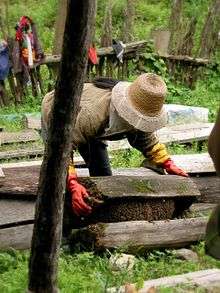Baima people
The Baima people (simplified Chinese: 白马人; traditional Chinese: 白馬人; pinyin: Báimǎ rén; lit.: 'White Horse people'), also called Baima Tibetans (simplified Chinese: 白马藏人; traditional Chinese: 白馬藏人; pinyin: Báimǎ Zàngrén), are a subgroup of Tibetans living in the southeast of Gansu and the northwest of Sichuan in China, especially in Pingwu and Jiuzhaigou Counties of Sichuan and Wen County, Gansu.
 "Baima": traditional honey making in Sichuan | |
| Total population | |
|---|---|
| 15,000 | |
| Regions with significant populations | |
| Wen County of Gansu Province, Pingwu County and Jiuzhaigou County of Sichuan Province, China | |
| Languages | |
| Baima language | |
| Religion | |
| Tibetan Buddhism | |
| Related ethnic groups | |
| Tibetan people, Qiang people |
Like the Songpan people of Tibet, Baima people call themselves Bai. Unlike Standard Tibetan, the Baima language does not use a written script, although a hieroglyphic system is used in religious practice. In religion, they still keep ancient nature worship and totem worship, which practices were later influenced by Bon, and in some degree they also believe Buddhism and Daoism, but there are no temples or lamas (monks).[1][2] To many of the Baima, the Mountain God is the highest god. The most important religious event for them is the Caogai Dance (曹蓋, which means domino in Baima).
The Baima people are said to be the descendants of Baima Di (白馬氐) and after Songtsen Gampo established the Tibetan Empire, they gradually became part of the Tibetan people.[3] The Di (氐) were an ancient large ethnic group living in west China who were associated with the Qiang (羌), also called Di Qiang (氐羌).[4] The change from their original Di language to Amdo Tibetan probably took place in the 7th century CE.[5] The area Baima people live in is the region that was previously called Jiandi Dao (湔氐道) before the Tibetan empire was established.
References
- [杨冬燕](白马)藏族信仰习俗现状调查研究
- "多元文化下的白马(氏人)文化". Archived from the original on 2013-06-18. Retrieved 2013-08-25.
- 被历史遗忘的民族--白马藏人
- "國立國父紀念館館刊第 14 期 164-180走向遠東的 兩個現代人種" (PDF). Archived from the original (PDF) on 2007-10-04. Retrieved 2013-08-25.
- Katia Chirkova: Baima: From language to dialect (University of Leiden lecture)